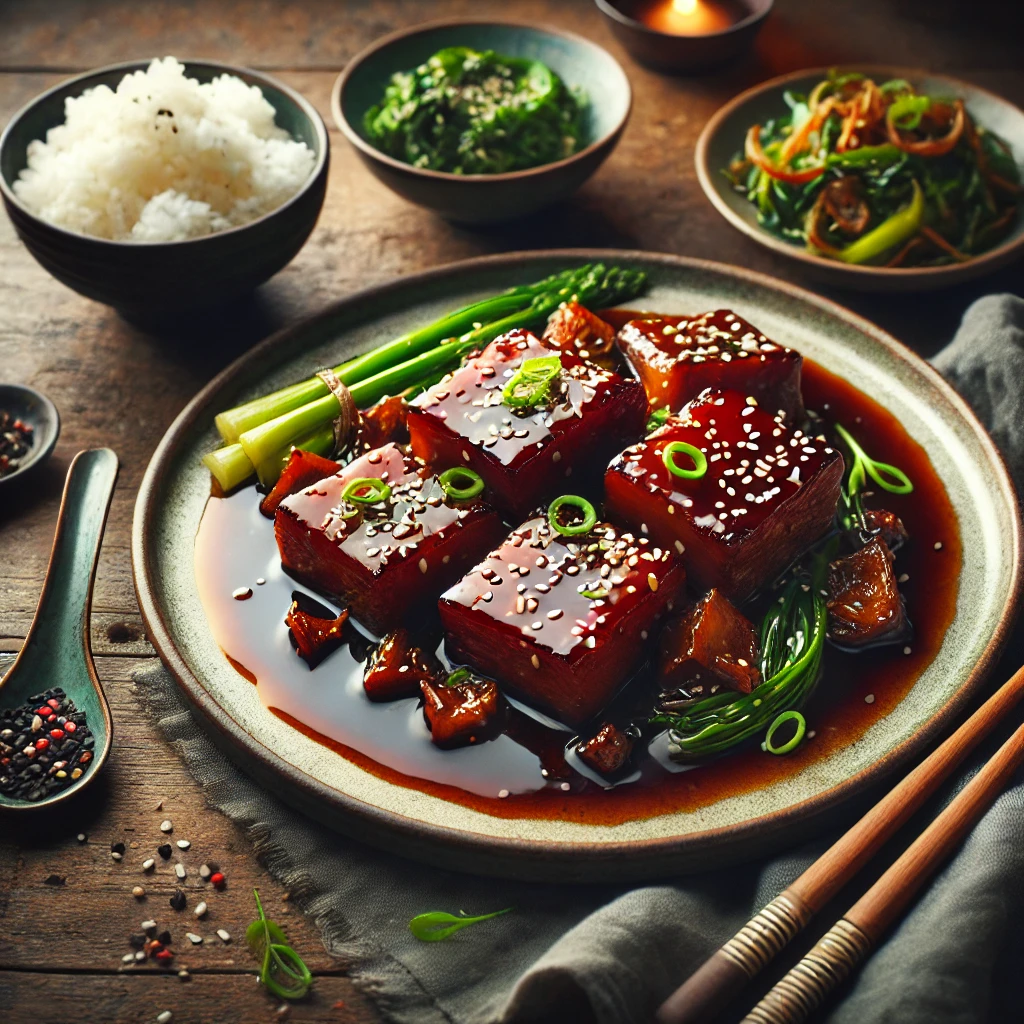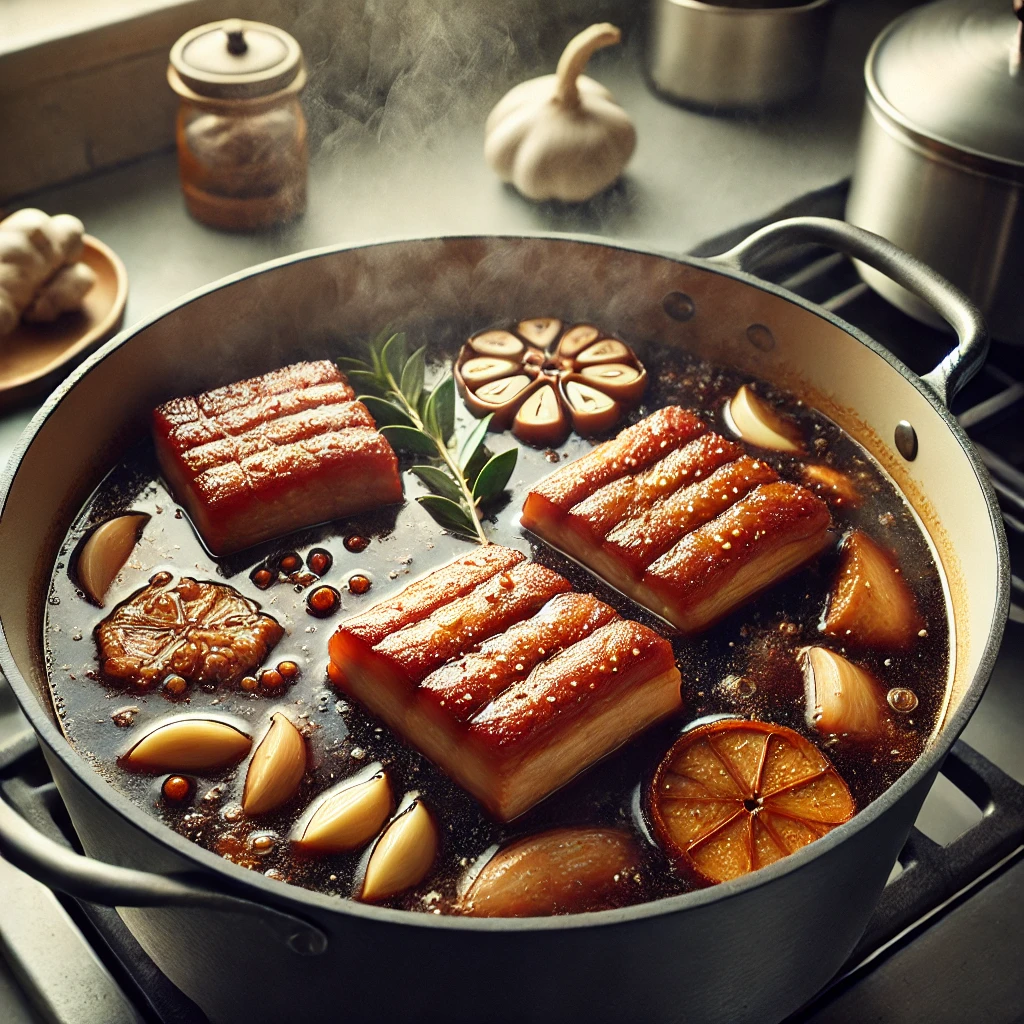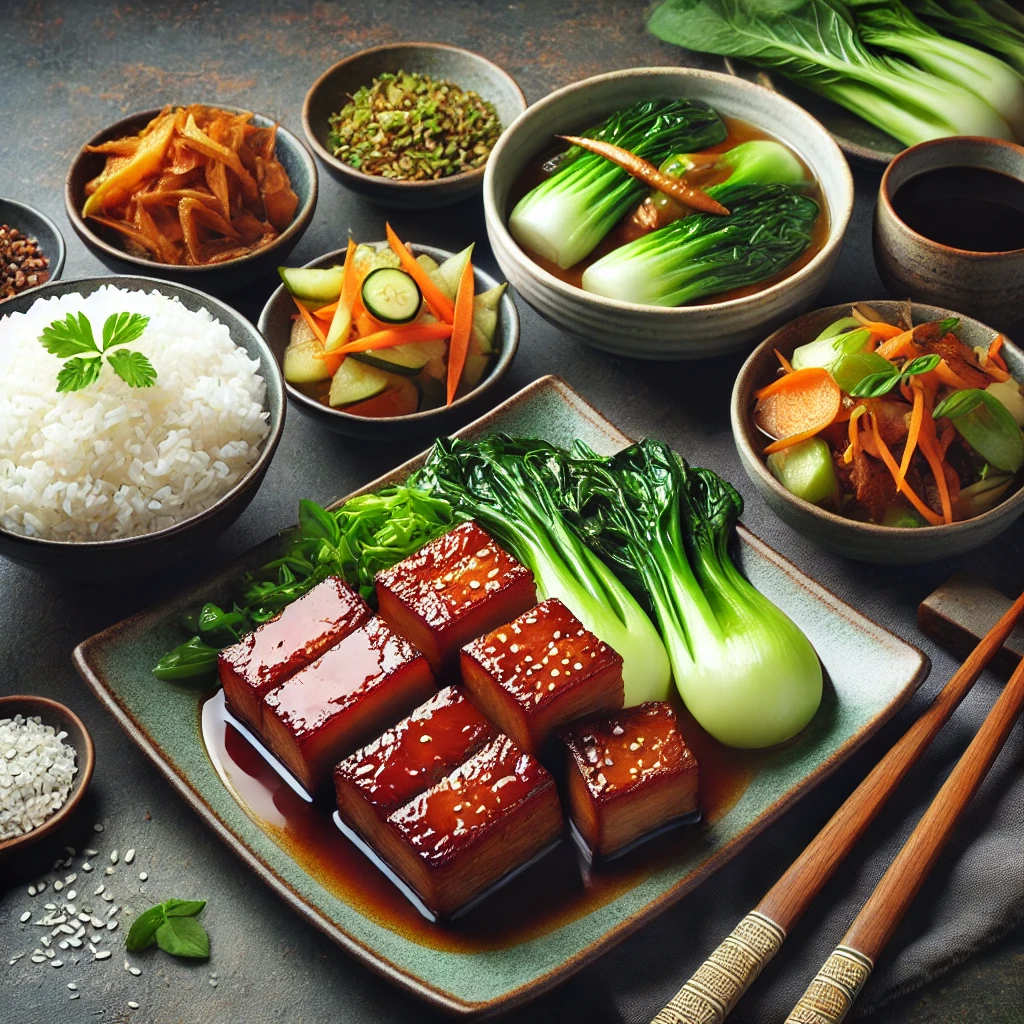
If you’re looking for a hearty and flavorful dish that’s surprisingly easy to make, braised pork belly with soy and ginger is the answer.
With rich, melt-in-your-mouth pork belly simmered in a savory, slightly sweet soy-ginger sauce, this recipe is the perfect comfort food for any weeknight dinner.
The best part?
You don’t need to be a gourmet chef to pull it off—just a few key ingredients and some simple steps, and you’ll have an irresistible meal that’s sure to impress your family or guests.
Why This Recipe Works for Weeknights
This recipe is ideal for busy weeknights because it requires minimal prep work and uses one pot.
While the pork belly simmers, you can unwind or prepare your sides.
Plus, the braising process guarantees tender meat without constant attention, making this a foolproof recipe.
Whether you’re feeding a crowd or just cooking for yourself, this dish delivers restaurant-quality results without the hassle.
Ingredients Overview
The magic of this recipe lies in a handful of simple, flavorful ingredients that are likely already in your pantry.
- Soy Sauce: Adds deep umami and saltiness to the dish.
- Ginger: Provides a subtle spicy warmth that complements the richness of the pork.
- Pork Belly: The star of the show—its fatty layers melt down into tender bites, making each mouthful luxurious.
- Garlic: A must-have for any braised dish, adding aromatic depth.
If you don’t already have these ingredients at home, you can easily find them on Amazon with quick delivery:
Equipment & Appliances:
Instructions:
- Prepare the Pork Belly: Heat the vegetable oil in your pot over medium-high heat. Sear the pork belly pieces until browned on all sides, about 5-7 minutes. Remove the pork from the pot and set aside.

2. Sauté Aromatics: Lower the heat to medium and add the minced garlic and sliced ginger to the pot. Sauté for 1-2 minutes until fragrant.
3. Make the Braising Liquid: Add soy sauce, dark soy sauce, brown sugar, and rice vinegar to the pot. Stir and cook for 1 minute to dissolve the sugar.

4. Braise the Pork Belly: Return the pork belly to the pot and add enough water or chicken stock to just cover the pork. Bring the mixture to a boil, then reduce heat to low, cover, and let simmer for 1 to 1.5 hours until the pork is tender and the sauce has thickened.

5. Serve: Garnish with sliced green onions and a drizzle of sesame oil. Serve the pork belly over steamed rice or with sautéed vegetables.
Health Benefits of Pork Belly
While pork belly is often considered a rich and indulgent food, it also contains essential nutrients when enjoyed in moderation.
Here are some of the benefits:
- Protein Powerhouse: Pork belly is a great source of high-quality protein, which is essential for the support of muscle recovery, tissue maintenance, and overall body function. A serving of pork belly can help meet your daily protein needs.
- Rich in B Vitamins: Pork belly contains several B vitamins, such as B6 and B12, which are critical for maintaining energy levels and supporting brain health. These vitamins also play a role in converting food into energy and in forming red blood cells.
- Source of Collagen: The skin and fatty layers of pork belly contain collagen, a protein that supports skin elasticity, joint health, and gut health.
- Ginger’s Health Perks: This dish isn’t just about the pork—ginger adds its own nutritional benefits. Known for its anti-inflammatory properties, ginger can help with digestion, reduce nausea, and even lower blood sugar levels. Including ginger in your diet can be particularly helpful for supporting gut health and easing muscle pain.
While pork belly should be enjoyed as part of a balanced diet due to its fat content, it can offer some health benefits when eaten in moderation.
Common Mistakes to Avoid
Even with a simple recipe, there are a few potential pitfalls to watch out for. Here’s how to avoid them:
- Skipping the Sear: Searing the pork belly before braising is critical for building depth of flavor. The caramelization that occurs during searing enhances the taste of the finished dish, giving the pork belly a rich, smoky undertone. If you skip this step, the meat will lack that extra dimension of flavor.
- Not Cooking Low and Slow: Braising is a slow-cooking method designed to break down tougher cuts of meat into tender, flavorful bites. Rushing the cooking process or turning up the heat can result in tough, chewy pork belly. Always cook the dish on low heat for at least 1 to 1.5 hours to ensure the pork becomes melt-in-your-mouth tender.
- Using Too Much Liquid: The goal of braising is to submerge the meat just enough to keep it moist without drowning it. Too much water or stock will dilute the concentrated flavors of the soy sauce and ginger. Start with enough liquid to cover the pork belly, and if you find the sauce is too thin at the end, simmer it uncovered to thicken.
How to Store and Reheat

This dish is even better the next day, as the flavors continue to develop.
- Storage:
- After cooking, let the pork belly cool to room temperature before transferring it to an airtight container. Refrigerate it for up to 3 days.
- If you want to store it for longer, transfer the pork belly and sauce to a freezer-safe container. The dish can be frozen for up to 3 months.
- Reheating:
- Stovetop Method: The best way to reheat braised pork belly is on the stovetop. Place the pork and sauce in a pan over low heat, adding a liquid ( water or stock) if the sauce has thickened too much. Heat gently until the pork is warmed through.Microwave Method: If you’re short on time, the microwave is a quicker option. Place the pork belly in a microwave-safe dish and heat on medium for 2-3 minutes, stirring occasionally to ensure even heating.
Substitute Ingredients
Don’t worry if you’re missing a few ingredients—this recipe is flexible, and substitutions can still produce delicious results.
Here are some easy swaps:
- Soy Sauce: Tamari or coconut aminos can replace soy sauce, especially if you’re looking for a gluten-free option. Both alternatives offer a similar umami flavor with a slightly different taste profile.
- Brown Sugar: If you’re out of brown sugar or prefer a healthier alternative, honey or maple syrup can be used. These natural sweeteners will add a unique depth of flavor to the dish, complementing the ginger and soy.
- Rice Vinegar: Don’t have rice vinegar? Apple cider vinegar or white wine vinegar can be used in its place. Both will give the dish the necessary acidity to balance out the richness of the pork belly.
- Pork Belly Substitute: If pork belly isn’t available, pork shoulder, beef short ribs, or even chicken thighs can work in this recipe. These cuts will still deliver tender, flavorful results after braising, though the cooking times may vary slightly.
What to Serve with Braised Pork Belly

Pairing the rich, succulent flavors of braised pork belly with complementary side dishes will elevate your meal to the next level.
Here are some ideas:
- Steamed Jasmine Rice: The neutral, fluffy texture of jasmine rice is the perfect accompaniment to soak up the savory soy and ginger sauce. Rice provides a comforting, simple backdrop to the bold flavors of the pork belly.
- Bok Choy Stir-Fry: Lightly sautéed bok choy with garlic adds freshness and a bit of crunch, balancing the richness of the pork belly. Its subtle flavor allows the main dish to shine, while still contributing a healthy green element to your plate.
- Pickled Vegetables: Tangy pickled cucumbers, carrots, or daikon radish provide a refreshing contrast to the fatty pork belly. The acidity from pickled vegetables helps cut through the richness and cleanse your palate between bites.
- Sautéed Spinach or Kale: For a more earthy, hearty green, a quick sauté of spinach or kale with garlic makes a nutritious and easy side dish that pairs beautifully with braised pork belly.
How to Make It Keto-Friendly
To keep this recipe keto-friendly, here are some simple adjustments you can make without sacrificing flavor:
- Use Low-Carb Soy Sauce: Regular soy sauce contains some carbohydrates, so opt for a low-carb version or tamari to keep it keto-compliant.
- Swap the Sweetener: Replace brown sugar with monk fruit sweetener or erythritol, both of which are keto-friendly and won’t spike blood sugar levels. These sweeteners will still help to balance the salty soy and fragrant ginger in the sauce.
- Serve with Cauliflower Rice: Instead of jasmine rice, serve the braised pork belly over cauliflower rice, which offers the same satisfying texture without the carbs. You can make your own by pulsing cauliflower florets in a food processor or buy pre-made cauliflower rice for convenience.
Recipe Card
Here’s the detailed recipe to make your very own Braised Pork Belly with Soy and Ginger at home:
Braised Pork Belly with Soy and Ginger

Braised Pork Belly with Soy and Ginger
Equipment
- Equipment & Appliances
- Large heavy-bottomed pot or Dutch oven
- Cutting board
- Sharp knife
- Wooden spoon
Ingredients
Ingredients:
- 1.5 lbs pork belly cut into 1-inch cubes
- 1/3 cup soy sauce
- 2 tbsp dark soy sauce optional for richer color
- 1/4 cup light brown sugar
- 4 cloves garlic minced
- 1 thumb-sized piece of ginger sliced
- 1 tbsp rice vinegar
- 2 cups water or chicken stock
- 2 tbsp vegetable oil
- 1 tbsp sesame oil optional
- 2 green onions sliced (for garnish)
Instructions
Instructions:
- Prepare the Pork Belly: Heat the vegetable oil in your pot over medium-high heat. Sear the pork belly pieces until browned on all sides, about 5-7 minutes. Remove the pork from the pot and set aside.
- Sauté Aromatics: Lower the heat to medium and add the minced garlic and sliced ginger to the pot. Sauté for 1-2 minutes until fragrant.
- Make the Braising Liquid: Add soy sauce, dark soy sauce, brown sugar, and rice vinegar to the pot. Stir and cook for 1 minute to dissolve the sugar.
- Braise the Pork Belly: Return the pork belly to the pot and add enough water or chicken stock to just cover the pork. Bring the mixture to a boil, then reduce heat to low, cover, and let simmer for 1 to 1.5 hours until the pork is tender and the sauce has thickened.
- Serve: Garnish with sliced green onions and a drizzle of sesame oil. Serve the pork belly over steamed rice or with sautéed vegetables.
Calories & Nutritional Info (per serving):
- Calories: 450
- Protein: 25g
- Fat: 35g
- Carbohydrates: 10g
- Sodium: 950mg
- Sugar: 8g
Notes
Sear for Flavor: Make sure to sear the pork belly well before braising to lock in the flavors and add a rich, caramelized crust. This step adds depth to the final dish. Choose the Right Cut: Pork belly with a good balance of fat and meat works best for this recipe. Ask your butcher for a well-marbled piece for maximum tenderness and flavor. Low and Slow: Braising on low heat ensures the pork belly becomes tender without drying out. Be patient, as slow cooking allows the fat to render properly, creating a melt-in-your-mouth texture. Skim Excess Fat: Pork belly is naturally fatty, so periodically skim any excess fat from the surface of the sauce to keep the dish balanced. Thicken the Sauce: If your sauce is too thin after braising, simmer uncovered for an additional 10-15 minutes to thicken it into a rich glaze. Make Ahead: This dish tastes even better the next day. Prepare it a day ahead and reheat for a deeper, more developed flavor. Adjust Sweetness: If you prefer a sweeter sauce, add a bit more brown sugar or a drizzle of honey for a touch of sweetness. Use Chicken Stock: For added richness, substitute water with chicken stock to enhance the flavor of the braising liquid. Serve Fresh Greens: Pair the pork belly with lightly sautéed greens like bok choy or spinach to balance out the richness of the dish with something fresh. These tips will ensure your braised pork belly turns out perfectly every time, delivering rich flavors and a satisfying meal.
Serving Suggestions
This braised pork belly with soy and ginger is best served over a bed of steaming white rice to soak up the rich, savory sauce.
Add a side of sautéed greens like bok choy or broccoli for balance.
For a little extra heat, you can also sprinkle some red pepper flakes or drizzle chili oil on top.
Here are some side dish suggestion to consider:
Why You’ll Love This Recipe
- Minimal Prep Time: With only 10 minutes of active work, the rest of the time is spent braising, so you can relax or focus on other tasks.
- One-Pot Wonder: This dish requires just one pot, minimizing cleanup time and effort.
- Rich and Comforting: The tender pork belly paired with the rich sauce makes this dish feel indulgent yet simple enough for any night of the week.
Tips for Success
- Use a Heavy Pot: A heavy-bottomed pot or Dutch oven helps distribute heat evenly, ensuring that the pork belly cooks uniformly.
- Skim the Fat: If you want a leaner dish, you can skim the fat off the top of the sauce as the pork belly cooks.
- Make It Ahead: This dish tastes even better the next day, as the flavors have time to meld. Store leftovers in the fridge for up to 3 days, and simply reheat before serving.
Optional Recipe Variations
- Add a Touch of Spice: For those who enjoy a bit of heat, add a sliced chili or a dash of chili oil to the braising liquid.
- Swap the Protein: If you’re not a fan of pork belly, you can substitute with chicken thighs or beef short ribs.
Love this recipe? Don’t forget to share your version of Braised Pork Belly with Soy and Ginger in the comments below.
If you’re looking for more weeknight dinner ideas, sign up for our newsletter to get new recipes delivered straight to your inbox.
Looking to level up your kitchen game?
Check out our recommended tools and ingredients on Amazon:
FAQ Section: Braised Pork Belly with Soy and Ginger

Here’s a detailed FAQ section to answer common questions about making Braised Pork Belly with Soy and Ginger. This section will help clarify any doubts and provide extra tips for the best results.
1. Can I substitute pork belly with a different cut of pork?
Yes, while pork belly is ideal for this dish due to its fat content that renders down during braising, you can substitute with other cuts of pork such as pork shoulder or pork butt. These cuts are also fatty and will become tender after slow cooking. Keep in mind, the texture and flavor may be slightly different, but it will still be delicious. If you prefer a leaner cut, consider pork loin, but be sure to monitor the cooking time closely to avoid drying it out.
2. How long should I braise the pork belly for best results?
For the best, melt-in-your-mouth results, you should braise the pork belly for about 1 to 1.5 hours on low heat. The key is to cook it slowly so that the fat renders and the meat becomes tender. If the pork belly is still tough after an hour, continue braising until it reaches your desired texture. Just ensure you have enough liquid in the pot to prevent the pork from drying out.
3. Can I make this dish in a slow cooker?
Yes, you can make Braised Pork Belly with Soy and Ginger in a slow cooker! After searing the pork belly and preparing the braising liquid on the stovetop, transfer everything to a slow cooker. Cook on low for 6-8 hours or on high for 3-4 hours, depending on your time constraints. The slow cooker will make the pork belly even more tender, and the flavors will have time to deepen.
4. How can I thicken the sauce most effectively?
If the sauce is too thin after braising, you can thicken it by removing the lid and simmering the dish uncovered for an additional 10-15 minutes until the liquid reduces to your desired consistency. Alternatively, you can mix 1 teaspoon of cornstarch with 1 tablespoon of cold water to prepare a slurry and mix it into the sauce. Simmer for a few minutes until the sauce thickens.
5. Can I prepare this dish ahead of time?
Absolutely! In fact, this dish tastes even better the next day as the flavors have more time to meld. Prepare the recipe as instructed, let it cool to room temperature, and then store it in your fridge ( upto 3 days is ok). When ready to serve, simply reheat it on the stovetop over low heat.
6. What side dishes go well with braised pork belly?
Braised Pork Belly with Soy and Ginger pairs well with a variety of side dishes, including:
- Steamed Jasmine Rice: The classic pairing to soak up the rich sauce.
- Stir-Fried Bok Choy or Spinach: Fresh greens add a balance of flavor and a refreshing contrast to the fatty pork.
- Pickled Vegetables: The tangy acidity from pickled cucumbers or carrots helps cut through the richness of the pork.
- Cauliflower Rice: A low-carb alternative to traditional rice, perfect for a keto-friendly meal.
7. Can I freeze leftover braised pork belly?
Yes! To freeze leftovers, let the pork belly and sauce cool completely before transferring it to a freezer-safe container. Freeze for 3 months or less. When you’re ready to eat, thaw it overnight in the refrigerator and reheat on the stovetop over low heat until warmed through. You may need to add a little water or broth to refresh the sauce.
8. How can I adjust the sweetness of the dish?
If you prefer a sweeter sauce, simply increase the amount of brown sugar in the recipe by 1-2 tablespoons. You can also add a drizzle of honey or maple syrup to enhance the sweetness. For a less sweet version, reduce the sugar by half or substitute it with a low-carb sweetener like monk fruit if you’re following a keto diet.
9. Can I make this dish gluten-free?
Yes, this dish can easily be made gluten-free by using tamari or coconut aminos instead of soy sauce. Both options provide similar umami flavors but without the gluten. Just make sure to check that all other ingredients, such as rice vinegar or dark soy sauce, are also gluten-free.
10. How do I know when the pork belly is done cooking?
The pork belly is done when it becomes fork-tender, meaning you can easily pierce it with a fork or knife without much resistance. The sauce should have reduced and thickened, coating the pork with a rich, flavorful glaze. If the pork is still tough after the recommended cooking time, simply continue braising it on low heat until it reaches the desired tenderness.
11. Can I substitute the soy sauce with a lower-sodium option?
Yes! If you’re watching your sodium intake, you can use low-sodium soy sauce instead of regular soy sauce. This will provide the same umami flavor without as much salt. You can also adjust the saltiness of the dish by adding water or stock to dilute the soy sauce as needed.
12. What should I do if my pork belly turns out too fatty?
Pork belly is naturally fatty, which is part of its rich flavor. However, if you find it too fatty for your taste, you can:
- Skim the excess fat: As the pork belly braises, some fat will rise to the surface of the sauce. Use a spoon to skim off any excess fat to lighten the dish.
- Trim the fat: Before cooking, you can trim some of the fat off the pork belly. However, keep in mind that the fat helps keep the meat tender and flavorful, so be careful not to trim too much.
Need More Delicious Ideas and Recipes?
Pork Belly Ramen Bowl Recipe: Your Guide to Restaurant-Quality Ramen
Crispy Oven-Roasted Pork Belly: A Simple Guide to the Best Crackling You’ll Ever Taste
As an Amazon Associate I earn from qualifying purchases.



